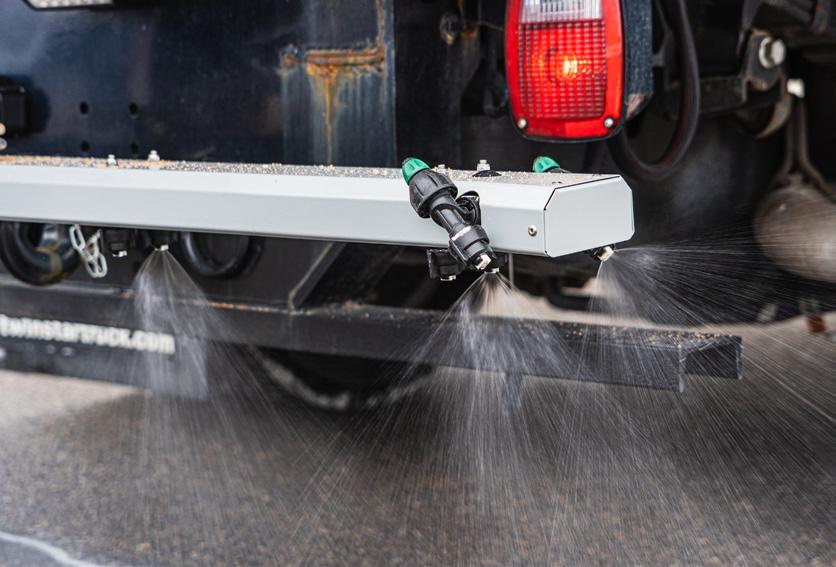
3 minute read
LIQUID COURAGE in the Form of DE-ICING
A look into the pros and cons of prewetting, anti-icing and liquid de-icing agents and how contractors can implement them into their operations.
Although prewetting, anti-icing and liquid de-icing are commonplace throughout Europe today, winter maintenance professionals in North America have been relatively slow to embrace the technology. However, it’s only a matter of time before liquids become the norm here, too.
Those who implement liquids now could gain a strong advantage over competitors who drag their feet. All it takes is a little liquid courage, so to speak.
Benefits
The biggest benefit is that salt costs can be reduced significantly. In fact, a 30 percent reduction in salt use is a realistic expectation at minimum. The majority of contractors probably save closer to 40 or 50 percent. In the right environment, some people have even saved up to 75 percent. The money saved on material can go directly to the bottom line.
The second major benefit of liquid ice management is the environmental aspect. When less salt is used, there is less salt that can potentially wash into waterways, landscaping and other sensitive areas. In some states, there’s legislation introduced to reduce salt usage. While it may not affect most contractors yet, we can only expect regulations to become more widespread and get more aggressive in the future.
Finally, liquids provide liability reduction. In our litigious society, we’re forced to manage snow and ice as effectively as possible or risk facing a lawsuit. Used properly, liquids can increase the effectiveness of a winter maintenance program.
Roadblocks
Roadblocks do exist on the path to liquid ice management, but they’ve gotten much easier to navigate in recent years.
For instance, many contractors aren’t sure how to actually get brine. Many assume they have to make it themselves, but then they see the cost of brine equipment and decide against it. Making brine also requires additional know-how and special licensing.
The best approach for most people is to purchase brine from chemical companies who know what they’re doing and have reliable manufacturing capabilities.
A bigger roadblock may simply be a lack of confidence in using liquids. Various factors, such as ambient temperatures, ground temperatures and weather forecasts, can affect the application and type of liquids used. A certain amount of education is needed to do the job right.
Luckily, that education is getting easier to find through online resources, professional associations and even governmental agencies.
Maybe you get off on changing blades at 2:00am in a freakin’ snowstorm – when you can’t feel your fingers and your knuckles are busted?

When it comes to more time in the driver’s seat and less time on your knees, nothing can touch carbide for long life! Our cutting edges with carbide inserts are setting records, and our carbide plow guards and curb guards help any new blade last 2x to 5x longer.
An often-overlooked resource is the brine supplier. Representatives from these companies can recommend exactly what liquids should be applied in each condition.
Another common roadblock in the move to liquids is how to bill for it. Contractors can often overcome this by remembering what exactly the client is paying for—a clear parking lot. The materials used are not of concern to them as long as expectations are met or exceeded. As a result, contractors can confidently bill the same amount for a job even if fewer materials are used.
Competitive advantages
In reality, billing should actually be considered an advantage to contractors who offer prewetting, anti-icing and liquid de-icing. Many clients would be happy to pay for services that are more environmentally friendly— especially if they work more effectively without costing significantly more.
Winter maintenance professionals can also benefit from the latest electricpowered equipment offerings.

Today, manufacturers have developed high-flow sprayers that are completely electric powered that can produce as much output as engine- or hydraulic-powered ones.

Additionally, advanced controls can help increase efficiency even further on some of the latest sprayers. For instance, software like tracking systems allow contractors to enter desired application rates for each jobsite. The operator can simply drive, and the equipment will automatically adjust the sprayer flow according to the vehicle speed in order to achieve the desired material rate for that property. The controller will also record all important jobsite data, providing documentation for use in billing or slip-and-fall disputes.
Sooner or later, brine will be adopted by many more people in North America, just as it has been in Europe. And, once again, the playing field will be level when the majority of contractors start prewetting, anti-icing and de-icing. In the meantime, there’s still opportunity to get some liquid courage…and start gaining your competitive advantage.
Craig Sandmann Managing Director Hilltip Corp.










